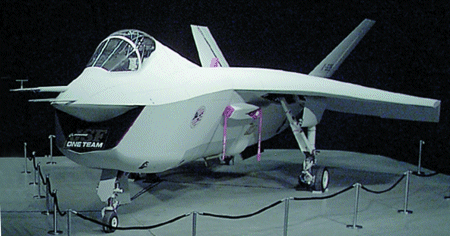Guy Norris/PALMDALE

Boeing unexpectedly rolled out both its X-32 Joint Strike Fighter concept demonstrators during a 14 December ceremony at its plant in Palmdale, California.
The conventional take-off and landing (CTOL) X-32A had been expected to make an appearance, but the short take-off, vertical landing (STOVL) X-32B's presence (above) was a surprise.
The X32-B appears to be externally complete but is awaiting its engine. The X-32A is fitted with a non-certificated Pratt & Whitney JSF119 that will be used for ground tests and will be replaced before the first flight.
Boeing says the roll-out reveals the efficiency and cost-effectiveness of its digital design and assembly techniques. These have allowed construction of the X-32B, which began six months after that of the X-32A, to be completed six weeks after its stablemate.
Assuming delivery of a flight-cleared engine early in the first quarter, Boeing hopes to begin flight-testing the X-32A in March.
Boeing JSF programme vice-president Frank Statkus says that the X-32B's first flight, scheduled for about 60 days after the CTOL version, has slipped by six weeks because of engine issues (Flight International, 1-7 December).
"We have experienced some issues and we are making sure all performance is at the levels predicted by the models," he says. "We are talking about fractions of a per cent, but it has to do with mass flow properties." Statkus says the propulsion team is working "to find out if it is the engine or the model that's wrong".
Boeing has confirmed it is still embroiled in solving development issues with early software for the integrated flight and propulsion control system, a critical element of the X-32B system.
Boeing is increasing the volume of risk-reduction work performed by the CDAs, and is studying extensions to the X-32B's planned flight test programme. The CDAs are tasked with proving commonality, low-speed flying qualities for the carrier version and STOVL hover and transition.
Boeing expects 85% of the X-32B's flight test work to be dedicated to performance requirements, and is considering test sorties that would include a short take-off, acceleration to supersonic flight and a vertical landing.
The X-32A, alternatively, is expected to have up to 85% of its planned flight test time (estimated at up to 50 flights and 100h), available for risk-reduction flights not required by the US Department of Defense.
Source: Flight International























